Delayed gratification. For many cigar smokers this is a way of life. We buy cigars, put them away, and smoke them only after they have had sufficient time to condition. In a sense, this is part of the excitement of smoking cigars. The anticipation of having a great smoking experience can be like foreplay, a teasing before the climax of lighting that great cigar.
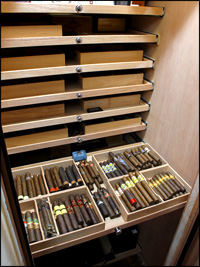
Happy cigars in their new home.
But this may not be true for habitual cigar smokers to whom such lofty expectations are a waste of time. To them it’s more about getting a good stick at a good price and smoking it without any such “silliness”. But if you are reading this article you probably lean more towards the cigar aficionado side of things and can appreciate the more nuanced aspects of our passion.
The notion of delayed gratification also guides cigar collecting. In this case we are delaying gratification for years or perhaps even decades. We collectors have visions of smoking that extraordinary fifteen-year-old cigar, the flavor of which could only be achieved by aging. However, the challenges of aging cigars are many, with an outcome dependent on very careful cigar maintenance while in storage. When we first start smoking cigars life is simple; a single humidor is our only storage system. Yet even then a certain amount of vigilance is required to keep the cigars in good smoking condition. Making sure the temperature and humidity are in that 70/70 range (70 degrees, 70% relative humidity) is key and difficult to maintain. Plus finding a suitable cigar humidifier and an accurate hygrometer takes a bit of research and yields only fair results. The good news is a single humidor is relatively cheap; the accessories work well enough, and, with proper cigar rotation, are able to keep our sticks in good smoking order. However, as our collections expand, so do the number of humidors we keep. In my case I stopped counting at thirteen.
For me things were getting really out of hand. I had run out of places to put the humidors and the task of keeping them near 70% RH was daunting. Plus rotating hundreds of cigars in multiple humidors was a task I simply avoided. After nearly a decade of cigar collecting I was finally at the point where centralized storage was the only solution.
Cigar storage options…
The first step was to figure out what type of storage suited my lifestyle. Ideally I would have loved to have the equivalent of an in-home cigar store. The vision of slanted shelves, resplendent with open boxes of cigars in a cedar-paneled room would have been a-dream-come-true. So Option 1 was a walk-in humidor. But that would have required; 1) having a spare room that “The Mrs.” would agree to let me use; 2) a big construction budget; 3) a cigar collection large enough to justify a room of grand proportions. This fantasy lasted all of a minute as it failed on all three criteria…it didn’t take long to move onto Option 2: a cigar armoire.
Shopping the Internet for pre-fab cigar storage was fun. There were lots of units to choose from and some of the larger cigar storage armoires were surprisingly affordable. Choosing such an option had the additional advantage of being portable; if I were to move, I could take the unit with me. But in an armoire with multiple compartments and cabinets, each section would require its own independent humidification. That meant multiple humidifiers all of which would need careful monitoring. My feeling was: “been there, done that”. Plus I was concerned about construction and style. I saw nothing “Spanish enough” to go with my other furniture and the thickness of the construction materials was questionable. The cigar armoire was not the answer. The only solution that seemed to work for me was then Option 3: a closet humidor.
A closet humidor offered many advantages: 1) I had a closet in a location that was close to where I smoke; 2) “The Mrs.” agreed to let me use it; 3) it was just the right size to hold my current collection yet large enough for expansion; 4) was located in the coolest part of the house (no need for air conditioning); 5) was near AC power; 5) would provide lots of wall thickness to retain humidity; and 6) was small enough to construct within my allotted budget. I was good to go.
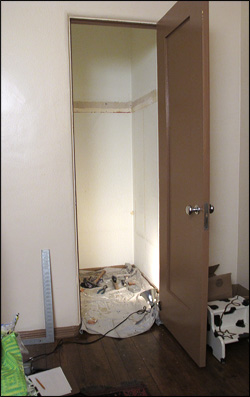
Closet before makeover.
The design…
The closet I chose was smaller than I would have liked, but it was the only game in town. It was clear from the start that I needed a design that was efficient and could store as many boxes and loose sticks as possible. Slanted shelves were not an option; I needed to stack boxes rather than display them. But years of buying “five packs” and cigar samplers have left me with hundreds of loose sticks and these needed to be dealt with as well. After much dwelling I decided to use pullout drawers with low sides and backs, set four inches above each other. The low sides would allow air to circulate while four inches would also accommodate low profile cigar boxes. I figured ten inches of space for the box drawers and shelves. That would allow for two or possibly three boxes to be stacked on each shelf. I also made all the drawers stop two inches from the back wall of the closet. I wanted air to circulate behind the shelves as well as the front.
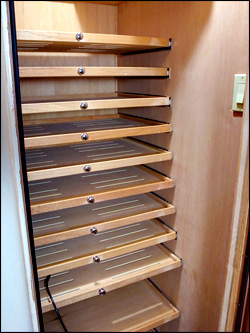
Drawers with low sides allow good air circulation.
The materials…
I live in Los Angeles and have access to just about everything. But kiln-dried Spanish cedar[i] was not easy to find, even in a megalopolis. Special ordering these materials from a local lumberyard was not an available option. For this I used Customcreation.net. Now, wood ain’t cheap, and neither is shipping such heavy materials, but I had to use Spanish cedar and that was all there was to it! The great thing about Customcreation.net was that they knew exactly what humidor builders need and carried everything from cedar crown molding to cedar plywood. They also made a cigar humidifier that was well suited for my application.
The construction…
I’m a pretty handy guy but lack of proper tools, very little woodworking skills, and a bad back precluded me from doing the construction myself. For that I used Sam Wilson, a local handyman, cabinetmaker, and aspiring actor. He understood what needed to be done and his eye for detail made him a good choice.
Prep…
The first step after demolition of the original closet interior was moisture proofing. Keeping all the precious moisture contained within the closet walls was important and for this we chose Hydro Ban. This non-toxic waterproofing material was the thickness of Elmer’s Glue and Sam applied it with a roller and paintbrush. But man, that stuff really stank! We had to call the manufacturer to make sure we weren’t asphyxiating ourselves. Once we got the go-ahead we finished applying the Hydro Ban but allowed a full week for it to cure before beginning construction.
There’s always something…
My home was built in 1929, and building anything inside an 82-year-old house can be frustrating. None of the walls are straight and there is not a true 90-degree angle in the entire structure. Fact is, everything in my house is constantly shifting and doors need almost annual adjustments to close properly. But the structure is sound and the house has withstood some pretty hairy earthquakes. She’s a good ol’ house, just a bit crooked. This was going to be an exacting job.
This lack of “trueness” required each draw to be cut to a unique length depending upon where on the wall it was to be placed. This required precision and considering the small variations and tolerances, it’s amazing that Sam was able to make each draw pull easily. Plus he painstakingly covered all the exposed plywood ends with cedar strips, a touch I really appreciate. Sam did a great job and I am eternally grateful.
The final part of the construction was lining the door’s interior with cedar and sealing it with weather stripping.
Seasoning…
This project took about six days to complete and when Sam finished I was anxious to load it full of cigars and crank up the humidifier. But seasoning was important and again, delayed gratification needed to prevail.[ii] After “misting” all the shelves with a light spray of distilled water, I turned on the humidifier and shut the door. I had no idea how long it would take for the closet to reach 70% RH and to my surprise, only took two days. I attribute this to the effectiveness of the Hydro Ban and that fact that the wood was stored outside and in the shade. The cool, damp West Los Angeles evenings worked magic on the uncut wood planks.
But I wanted to make sure the closet was truly conditioned and waited two full weeks before loading it with cigars. Once I was sure the RH was stable, I slowly added boxes and singles, at a rate of two shelves a day. Within a week I had emptied all my desktop humidors and was ready to see how the closet would perform.
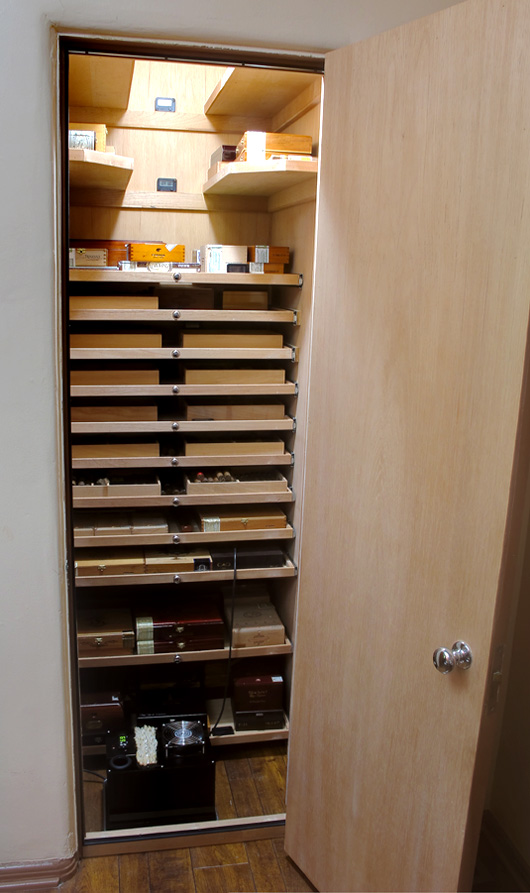
A thing of beauty.
Man, why did I wait so long?!…
After years of dealing with wet sponges, fluctuating humidity, inconsistent cigar conditioning, and the fear of dried cigars at the bottom of my humidors, I can finally rest comfortably knowing all my cigars are safe and happy. The closet humidor is performing beyond my expectations and my cigars have NEVER smoked better. The Custom Creations humidifier works like a dream and the RH level never fluctuates. By placing the humidifier on the floor the entire closet stays in the 70% range with only a 3% differential from ceiling to floor.
The successful completion of this closet humidor has elevated my enjoyment of smoking cigars in ways I never anticipated. One is the wonderful aroma of cedar and tobacco that, like fresh roses at a florist, envelops you when the door is opened. Another is that all the cigars have attained that great “barnyard smell”.[iii] Putting a cigar to one’s nose and smelling rich tobacco is a wonderful part of the cigar smoking ritual; now I can experience this with every cigar. Another advantage is the ability to group similar cigars together. I subscribe to the theory that cigars will exchange flavors when stored together and have arranged the shelves according to strength and wrapper type. And lastly; the ability to easily browse my cigar collection and select the cigar I want to smoke. No more fumbling through layers of cigars in multiple humidors, neglecting cigars at the very bottom.
Final thoughts…
For me, delayed gratification has paid off; I am now reaping the rewards of a cigar collection that is finally reaching maturity. (If anyone is putting off buying that extra box for aging, I encourage you to wait no longer. Most any cigar will get better with age and it’s great fun to taste the aging process as it progresses.) With the construction of a cigar closet I feel a load of responsibility has been lifted from my shoulders. The need to protect my cigar investment has finally been met and I am free to enjoy my cigar collection knowing all is well in cigar land. But for me, this construction project means more than just a simple storage solution. I believe it is the little things in life that are the most rewarding, and smoking a small cylinder of tobacco is one of life’s great pleasures. In a sense my cigars are like jewels to be admired as well as smoked, and having a shrine in which to keep my treasures is only giving them what they deserve…a place of honor in my home and a protected palace of their own. If you’ve got an extra closet, and plan on starting a cigar collection, I highly recommend building a cigar closet. But don’t put it off…I should have done this years ago. Mmmm, think I’ll go look at my cigars…
Thanks for listening,
Joe
[i] Kiln-dried Spanish cedar is an aromatic wood used in humidors and cigar boxes. Some cigar makers will actually wrap cigars in this material as it imparts a nice flavor to the cigars themselves.
[ii] Seasoning a humidor is the process of bringing its wood interior up to proper moisture levels before the addition of cigars. Without seasoning, the dry wood will draw moisture from of the cigars, making them brittle.
[iii] “Barnyard smell” is a term some cigar smokers use to describe the earthy aroma of good quality cigars that have been perfectly conditioned. The great Cuban cigars all seem to have this characteristic.








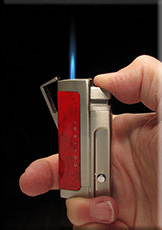

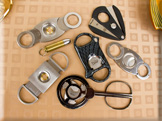

Looks great, congratulations.
W
Excellent reportage on the contruction of your cigar closet. It’s nice to have that warm feeling of accomplishment. Congrats and may it serve you well for many years to come.
Thats Awesome. I want one. Send your builder and the materials my way. Did you ever consider putting on a glass door? I’d love to show off my stash.
I am thinking about this seriously. I am not planning to move in my lifetime, and I have 6 Humidors, all full already. I’m still not sure what you meant by the high humidity in west Los Angeles–I grew up there, and it was usually dry-LOL. I live in Louisiana now, and average RH is 75. Many days, much more. This is great, it will be my modle. I am wanting to keep the cigars in there boxes anyway.
Ken, I think when compared to Louisiana, West LA is VERY dry! LOL But we got a damp sea breeze in the evenings with lots of dew.
As far as building a cigar closet in such a humid environment, I think you may run into the issue of your sticks getting moldy. I’m finding that even in LA, some of my sticks have developed mold. (I’ll be writing a follow-up article soon. The mold is the harmless white kind [no it’s not bloom] that rubs off and doesn’t effect the taste. Actually I smoked one of the moldy cigars last night and it tasted great.) My humidor hardly runs at all so in a more humid environment, you may need to dehumidify your closet, especially if the temperature goes up. As far as my mold issue goes, I think the humidifier itself is the source but I’m not sure. I noticed mold on the humidifiers wick so that may be throwing off spores. I’m still experimenting, trying to get it just right. I guess I’m the guinea pig for the cigar closet thing. Stay tuned for a more in depth analysis.
Active reader here,
Could you share in greater details where you got the cedar trays on rails? As well as the lighting system you went with. I looked at Customcreation.net and did not see details about the trays or rails.
Thanks
Eric Hayslett
Eric, all the shelves were custom built for the closet. I am using individual cigar trays to group the sticks together. I got them at Cheaphumidors.com
Hope this helps,
Arthur
Also, I am using a simple single florescent bulb fixture at the top of the closet. I used additional lighting for the photos.
My 4.5 years living in Pebble Beach, CA were the best and easiest for my cigars. The average temp 365 days a year is 67 degrees and the average humidity was 68. I had 5 humidors holding between 400 and 550 sticks. Almost zero maintenance. Now that I’m back in LA I am constantly fighting temp an RH fluctuation.
I have been admiring this project for several years. I am currently finishing my basement and wondered if after a few years you have any additional thoughts? Is there anything you would have done differently.
I am thinking of a standard 2 ft. Deep closet about 30″ wide. So each shelf will have 2 trays as opposed to your four.
Fortunately for me, my son is a meticulous custom cabinet maker/designer 🙂
Hi Bill.
I love my closet and there is nothing I would change. But I was never able to find a way to cool it. It stays pretty warm in there (75 degrees) and I have had bug issues in the past. That got fixed when I froze all my cigars and put everything in boxes. I don’t keep any loose sticks uncovered. But all in all, my cigars stay perfectly humidified and are aging well. The only thing I would stress for your project is that you have good air circulation and keep a fan running all the time. For good airflow, my pull-out shelves leave a 2″ gap at the back wall when pushed in.
Let me know how your project progresses.
Arthur